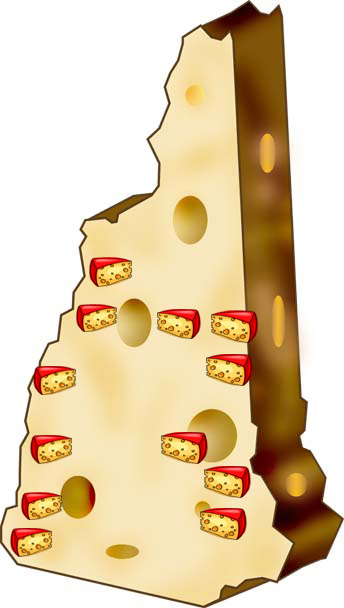|
June, 2012
Food For Thought |
June is National Dairy Month
June 5: Ag Awareness Day at Haverhill Cooperative Middle School
June 8: Health Awareness Day at Haverhill Cooperative Middle School
June 5-7: School to Farm Days at UNH, Durham
June 19-22: National Ag in the Classroom Conference, Loveland CO
www.agclassroom.org/conference
June 26-28: NH Science Teachers Summer Institute, Concord
www.nhsta.net | |
|
Cheese Facts
- There are over 2000 varieties of cheeses.
- Cheese takes up about 1/10th the volume of the milk it is made from.
- Almost 90% of all cheeses sold in the U.S. is classified as a cheddar type cheese.
- In 2010, there were 10.4 billion pounds of cheese produced in the U.S.
- In 2010 the U.S. per capita consumption of cheese reached an all time high of over 33 pounds.
- The first cheeses were made from sheep milk.
- Cheeses contain living organisms.
- Natural cheeses are defined as those made directly from milk or whey.
- The Pilgrims included cheese in the Mayflower's supplies when they came to America in 1620.
- The first cheese factory in America was built in Oneida, NY in 1851.
| |
|
Dairy and Cheese Resources
NH Agriculture in the Classroom -
nhaitc@nhfarmbureau.org
We have a lesson packet for teachers about dairy, we can provide you with a list of dairy farms in your area and are happy to help with any questions.
Granite State Dairy Promotion - www.nhdairypromo.org
This site lists a summary of the history of dairy in NH, provides facts and photos, activities and information. There are also ongoing events where you can participate in dairy promotion throughout the state.
NH Wine & Cheese Trail -
http://www.visitnh.gov/where-to-eat/wine-and-cheese.aspx
This is a guide to wineries and farms throughout the state which combine to make an enjoyable adventure as well as a great lesson in agriculture (skip the wineries with your students, or plan a nice summer excursion for yourself)
American Dairy Association - http://www.adadc.com
A trade association for dairy producers. This site has information for educators and school nutritionists about the health benefits of dairy products.
Animal, Vegetable, Miracle - http://www.animalvegetablemiracle.com/
This site is based on the book by the same title, written by Barbara Kingsolver and her family. She provides recipes for eating locally and in season. A 30-minute mozzarella cheese recipe is listed under the summer recipes and is easy to do at home or at school.
Cabot Cheese - http://www.cabotcheese.coop
A cooperative of New England farmers who pool their resources and products to produce Cabot Cheese. The website has some history, information about cheeses and resources for teachers and youth leaders about how Cabot helps with fund raisers and grants that focus on health and nutrition.
I Love Cheese - http://www.ilovecheese.com/
A source for information about different kinds of cheeses, recipes, cheese trends and more.
This is the home to several groups including the National Cheese Institute. There are rich pages on the history of cheese, different types of cheeses, cheese facts and recipes.
National Historic Cheesemaking Center http://www.nationalhistoriccheesemakingcenter.org
A facility in Wisconsin which tells the story of cheese, its history, process and importance. It has a photo gallery displaying historical tools and cheese making processes.
New England Dairy Council - www.newenglanddairycouncil.org
This is primarily an industry focused site but does have an education page with activities, posters, games and resources for educators, including a video on the story of milk.
Contacts:
NH Ag in the Classroom
Ruth Smith, Statewide Coordinator
nhaitc@nhfarmbureau.org
603-224-1934
295 Sheep Davis Road
Concord, NH 03301
Deb Robie, Grafton County Coordinator
| |
|
|
|
Greetings,
June is National Dairy Month, a great time to celebrate all of the farmers who raise the animals that provide the milk which is the source of so many products that we enjoy. It's easy to come up with a short list of typical dairy products like milk, butter, cheese, yogurt, and ice cream. But why not challenge your students to see how long a list they can make. Send them on a field trip to the grocery store or to their kitchen at home and look for dairy ingredients hidden in other foods. It might surprise them (and you) to learn how many different places dairy products show up. Things like chocolate and baked goods are made with milk. Whey, a by-product from making cheese, is put into many prepared and processed foods such as canned goods, sauces and condiments. For people who are lactose intolerant or have allergies to diary products it can actually be difficult to find foods that are dairy-free.
The history of dairy farming in New Hampshire is fascinating and filled with mystery, drama, suspense and some great stories. To get a timeline summary (D airy Facts & Myths) or a detailed book (The History and Economics of the New Hampshire Dairy Industry) on the topic, visit the Granite State Dairy Promotion website: http://nhdairypromo.org/. While there you will also find a link to the New Hampshire Cheesemakers Guild. This link provides a list of some of the cheese makers in airy Facts & Myths) or a detailed book (The History and Economics of the New Hampshire Dairy Industry) on the topic, visit the Granite State Dairy Promotion website: http://nhdairypromo.org/. While there you will also find a link to the New Hampshire Cheesemakers Guild. This link provides a list of some of the cheese makers in
the state. These include goat's milk cheese makers as well as those who use cow's milk. Some of these people might be interested in talking to students about how cheese is made or allow field trips to their farm to see their animals and operation. If you have never been in a cheese cave, it's quite an experience.
In this issue we'll focus on cheese and how to use it as an integrating theme in your class. If you are interested in other dairy ideas see the May 2011 issue of Food for Thought which provides instructions for making butter in the classroom as well as some other tips.(http://archive.constantcontact.com/fs083/1102560151594/archive/1105311849829.html)
There will be a combined July/August summer issue of Food for Thought coming out in mid-summer. I'll be at the National Ag in the Classroom conference in late June, but just because summer is coming doesn't mean our work stops. We're here for you as you think about plans for next year. Let us know how we can help.
Have a great summer,
Ruth
Ruth Smith, Statewide Coordinator
NH Agriculture in the Classroom |
|
Cheese Lessons - A Real Taste Test
It's hard to pick a favorite dairy product but cheese is a top contender for many of us. Yet how much do we really know about how cheese is made, why there are so many different kinds and why cheese first came into production. Exploring these topics can give a new focus to history, science and geography lessons.
There are records of cheese making that go back at least 4000 years. Legend has it that the first cheese was made accidently by a shepherd carrying milk in a pouch made of a sheep's stomach. Rennet, an enzyme in the lining of the stomach, combined with heat causes milk to separate into solids (curds) and liquid (whey). The curds are what become the cheese.
The science of cheese making has to do with pH. When the enzyme rennet is added to milk it stimulates the lactic bacteria to convert lactose (milk sugar) into lactic acid, thus lowering the pH of the milk. A coagulant (like citric acid) may also be used to help separate the solids from the liquid part of the milk. The acidity destroys any harmful bacteria. This is one of the reasons why cheese lasts much longer than liquid milk.
The history of cheese making can be a great research project. It evolved from a family centered activity as a way to preserve excess milk from the family cow to a cottage industry to cheese factories. To learn more visit (http://www.nationalhistoriccheesemakingcenter.org/Cheesemaking-History.aspx) Also see the resource list for sites with historical information and facts.
The journey of cheese from Middle Eastern regions to the Mediterranean and Europe and finally to the Americas is a way to learn about human migration trends and culture. Cheese traveled with its makers but also maintains unique characteristics that ground varieties to their places of origin.
Book (and electronic) learning is interesting but nothing beats the hands-on experience of making your own cheese. A relatively easy and quick recipe for mozzarella can be found at http://www.animalvegetablemiracle.com/. This process requires a stove or heating element but is not complicated.
As with any activity that involves making and consuming food with children, check with your school nurse to make sure you don't have any students with allergies or to learn about school rules that may impact your process. Hopefully you will not encounter stumbling blocks to making and eating this product because students (of any age) will look at cheese differently after they have created some of their own and eaten it fresh. |
|
The End is Near!!
by Deb Robie
Some folks think that a teacher's responsibilities end on the last day of school. If you are a teacher you know that is not the case. For many it is just a time to take a few well deserved breaths and start looking forward to the next school year.
Teachers might ask: Did I accomplish all I wanted to with my students? What else could I have done to help my students succeed? Did I take the time to recharge my own batteries so that I could be a positive influence on my students?
Here at NH Ag in the Classroom we want to be able to help you answer all of those questions and more. We have a multitude of resources to help teachers be the best they can be.
Did you know that every year there is a national Ag in the Classroom conference designed by teachers for teachers to show you what other programs are doing across the country? There are large grant dollars available for teachers to help enhance or begin programs at your school. There are workshops, tours and a lot of time dedicated to just talking with fellow teachers.
The conference is held in various parts of the country. This year it is in Colorado. For a taste of what the conference is all about check out www.agclassroom.org/confernce. It would be well worth the time to go next year when it will be in Minnesota.
The end of the year brings many emotions. The stress of testing, realizing that next year brings a new group of students to get to know and maybe even a new school for you.
Let us be there to help you help your students.
|
|
|